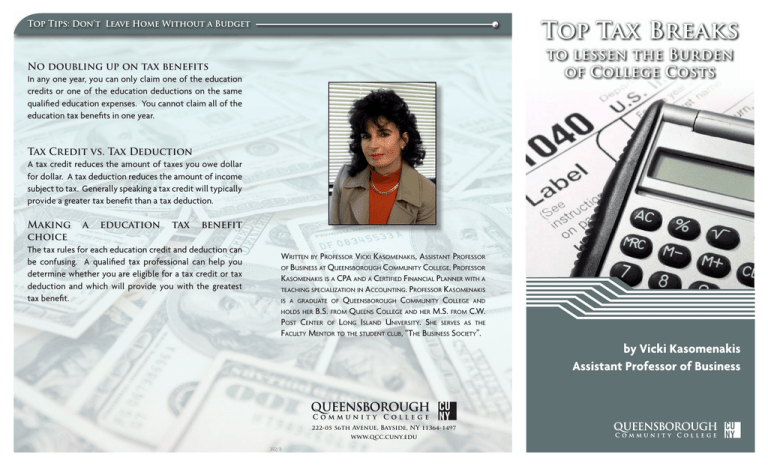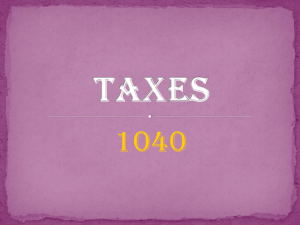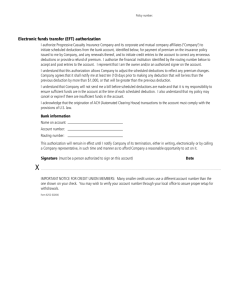Document 11163773
advertisement

Top Tax Breaks Top Tips: Don’t Leave Home Without a Budget to lessen the Burden of College Costs No doubling up on tax benefits In any one year, you can only claim one of the education credits or one of the education deductions on the same qualified education expenses. You cannot claim all of the education tax benefits in one year. Tax Credit vs. Tax Deduction A tax credit reduces the amount of taxes you owe dollar for dollar. A tax deduction reduces the amount of income subject to tax. Generally speaking a tax credit will typically provide a greater tax benefit than a tax deduction. Making choice a education tax benefit The tax rules for each education credit and deduction can be confusing. A qualified tax professional can help you determine whether you are eligible for a tax credit or tax deduction and which will provide you with the greatest tax benefit. Written by Professor Vicki Kasomenakis, Assistant Professor of Business at Queensborough Community College. Professor Kasomenakis is a CPA and a Certified Financial Planner with a teaching specialization in Accounting. Professor Kasomenakis is a graduate of Queensborough Community College and holds her B.S. from Queens College and her M.S. from C.W. Post Center of Long Island University. She serves as the Faculty Mentor to the student club, “The Business Society”. by Vicki Kasomenakis Assistant Professor of Business 222-05 56th Avenue, Bayside, NY 11364-1497 www.qcc.cuny.edu 392/11 Top Tax Breaks to Lessen the Burden of College Costs Top Tax Breaks to Lessen the Burden of College Costs If you’re currently a college student or are planning to go to school in the near future, beware, the cost of going to college continue to rise faster than the rate of inflation. The average cost of tuition, room and board at a private four year college is approximately $36,993.00 this year. Just think you’ll have to pay close to $150,000.00 to get your undergraduate degree. These numbers are quite staggering. Fortunately, there is some financial relief on the horizon. The Federal government has enacted numerous education tax credits and deductions to help you defray some of the college costs. As you prepare your federal income tax return, check to see if you qualify for any tax savings under the following enacted tax provisions. 1. The Hope Scholarship Tax Credit You may be able to reduce your federal income tax as much as $1,800.00 per year for out-of-pocket qualified education expenses such as tuition, fees, qualified books, supplies and equipment . The credit can only be used for the first two years of post secondary education leading towards an undergraduate degree. Students must be enrolled at least half time in a degree program. 2. The American Opportunity Tax Credit 4. Student Loan Interest Deduction The American Opportunity Credit was signed into law in 2009 as part of the 2009 Economic Stimulus Plan approved by President Obama. This credit expands, increases and replaces the Hope Scholarship Tax Credit for tax years 2009 and 2010. With this credit you may be able to reduce your federal income tax as much as $2,500.00 per year per student for out-of-pocket qualified education expenses. The credit is available for each of the first four years of post secondary education leading towards a degree or certificate. Students must be enrolled at least half time in a degree or certificate program. In addition, 40% of the credit is refundable which means that even if you don’t owe any federal taxes you could get money back from the federal government. The Obama Administration has proposed a permanent extension of this credit. If you took out a student loan to pay for your post secondary education, you may be able to deduct up to $2,500.00 of interest paid yearly. To qualify for the deduction, you must have used the loan proceeds to pay for higher education expenses including tuition, fees, room, board and other related expenses. The interest is deductible on your federal tax return as an “above the line deduction” which means you don’t have to itemize your deductions on your tax return in order to claim the deduction. 3. The Lifetime Learning Credit The Lifetime Learning Credit has fewer educational restrictions than the Hope Scholarship Tax Credit and the American Opportunity Tax Credit. This credit is not restricted to the first two or four years of school. The qualified education expenses are not restricted to undergraduate programs. The credit is available for students who take at least one course in virtually any college, university and vocational school. There is no requirement that a degree be pursued. In addition, there is no limit on the number of years the Lifetime Learning credit can be claimed. The maximum credit is $2,000.00 per family not per student. 5. Tuition and Fees Deductions Education expenses that qualify for this deduction include tuition, fees and other related expenses. Room and board or other personal expenses do not qualify for the deduction. The maximum deduction is limited to $4,000.00 per year and is deductible on you federal tax return as an “above the line deduction”. Income limitations on education tax benefits The education tax credits and deductions are limited over a phase-out income range. If your income is below the phase-out range, your education tax benefits are not reduced. If, on the other hand, your income is in the middle of the phase-out range, the tax benefits will be reduced. The tax benefit will be completely eliminated if your income exceeds the phase-out range.



